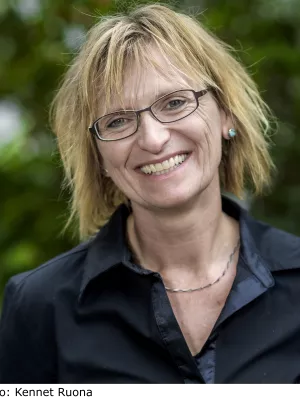
Natascha Kljun
Professor

Can thermal imagery improve ecosystem respiration modelling and UAV-based upscaling?
Författare
Summary, in English
Temperature is a key constraint on ecosystem respiration but is typically measured at only one or a few points across a study site. Given the exponential relationship between temperature and respiration, small differences in temperature across a heterogeneous ecosystem may result in large differences in respiration fluxes. These differences are not captured in current respiration models which use single measurements of air or soil temperature to represent a whole ecosystem. As a result, uncertainties are introduced when upscaling modelled respiration estimates or partitioning eddy covariance fluxes.
Thermal cameras provide a new method for observing the spatial variability of surface temperature across an ecosystem at a high temporal resolution. We used thermal images, air and soil temperature data to model chamber respiration measurements collected over the growing season at a peatland in central Sweden. The measurements covered the two main vegetation communities (bryophyte-dominated hollows and graminoid-dominated hummocks) present at the site. We tested whether surface temperature data from the tower-based thermal camera predicted ecosystem respiration more accurately than air or soil temperature. We also assessed the impact of vegetation heterogeneity on the modelled fluxes by comparing model accuracy when including either one or both
vegetation communities in a single model. Finally, we upscaled our modelled predictions to the whole site using a vegetation classification and thermal data collected with an Umanned Aerial Vehicle (UAV). We could thus quantify the uncertainties in modelled fluxes when using single versus spatially-distributed temperature estimates at the ecosystem scale.
Thermal cameras provide a new method for observing the spatial variability of surface temperature across an ecosystem at a high temporal resolution. We used thermal images, air and soil temperature data to model chamber respiration measurements collected over the growing season at a peatland in central Sweden. The measurements covered the two main vegetation communities (bryophyte-dominated hollows and graminoid-dominated hummocks) present at the site. We tested whether surface temperature data from the tower-based thermal camera predicted ecosystem respiration more accurately than air or soil temperature. We also assessed the impact of vegetation heterogeneity on the modelled fluxes by comparing model accuracy when including either one or both
vegetation communities in a single model. Finally, we upscaled our modelled predictions to the whole site using a vegetation classification and thermal data collected with an Umanned Aerial Vehicle (UAV). We could thus quantify the uncertainties in modelled fluxes when using single versus spatially-distributed temperature estimates at the ecosystem scale.
Avdelning/ar
- Centrum för miljö- och klimatvetenskap (CEC)
- BECC: Biodiversity and Ecosystem services in a Changing Climate
- MERGE: ModElling the Regional and Global Earth system
- Institutionen för naturgeografi och ekosystemvetenskap
Publiceringsår
2019
Språk
Engelska
Dokumenttyp
Affisch
Ämne
- Ecology
- Physical Geography
Conference name
2nd Nordic ICOS Symposium
Conference date
2019-10-24 - 2019-10-25
Conference place
Gothenburg, Sweden
Status
Published
Projekt
- CarboScale : Scaling carbon flux from towers to the northern landscape
- GREEN GAP: GREENhouse GAs flux uPscaling - improved understanding of key ecosystem processes using remote sensing and ground-based measurements